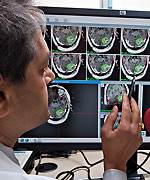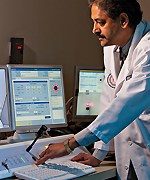What to Expect Before, During and After Gamma Knife Treatment
Gamma Knife is a well-established method to treat targets in the brain. Read below to learn more about the typical steps related to treatment. Please note that your treatment may vary based on your specific case.
The Stereotactic Head Frame
 One of the key components of the Gamma Knife — the tool that allows
your doctor to precisely pinpoint your tumor or problem — is the
special stereotactic head frame.
One of the key components of the Gamma Knife — the tool that allows
your doctor to precisely pinpoint your tumor or problem — is the
special stereotactic head frame.
This lightweight frame, which is attached to your head with four small screws, ensures that the radiation beams are precisely targeted.
The frame also prevents your head from moving during the treatment procedure, which ensures that only the target area in your brain receives radiation.
Imaging
 After your head frame is in place, a number of advanced imaging tests —
such as an MRI or CT scan — will be required to precisely locate
the size, shape and location of your tumor, lesion or abnormality. If
your physician is treating a blood vessel abnormality, an angiogram may
also be required. As you may know, an angiogram involves the injection
of a dye into your bloodstream so that the imaging procedure clearly shows
the blood vessels and arteries in the brain. The coordinate markers on
your head frame, which are part of the images taken, will help your physician
develop an exact plan for your procedure.
After your head frame is in place, a number of advanced imaging tests —
such as an MRI or CT scan — will be required to precisely locate
the size, shape and location of your tumor, lesion or abnormality. If
your physician is treating a blood vessel abnormality, an angiogram may
also be required. As you may know, an angiogram involves the injection
of a dye into your bloodstream so that the imaging procedure clearly shows
the blood vessels and arteries in the brain. The coordinate markers on
your head frame, which are part of the images taken, will help your physician
develop an exact plan for your procedure.
Treatment Planning
 Once your images have been taken, you can sleep, rest or relax while your
physician develops your specialized treatment plan. First, your brain
images are computerized. Then, using special software, a treatment protocol
is planned.
Once your images have been taken, you can sleep, rest or relax while your
physician develops your specialized treatment plan. First, your brain
images are computerized. Then, using special software, a treatment protocol
is planned.
No two treatment plans are alike; every patient’s plan is specifically designed to address his or her specific medical condition. Because Gamma Knife includes a set of unique helmets that have 201 holes for the precise delivery of radiation to your brain, your plan will consist of one or more treatments using these helmets.
The Treatment
 Once your treatment plan is complete, you'll lay down on the treatment
table and your head frame will be attached to the helmet for your first
treatment.
Once your treatment plan is complete, you'll lay down on the treatment
table and your head frame will be attached to the helmet for your first
treatment.
You'll be awake during the procedure and able to communicate with your physician and the rest of the team through a video and audio connection. When Gamma Knife treatment begins, the treatment table, which is much like the one you were on for your MRI or CT scan, will move into the dome section of the unit.
The team will be monitoring your procedure at all times.
There may be several treatments lasting anywhere from 2 to 45 minutes during your session.
Post-Treatment
Once your treatment is complete, the head frame will be removed. If you had an angiogram, you might have to lie quietly for several more hours. Some patients experience a mild headache or minor swelling where the head frame was attached, but most report no problems. Your doctor will tell you whether or not he wants you to stay overnight for observation or if you can go home immediately. Either way, you should be able to return to work or your normal routine in another day or so.
The effects of your Gamma Knife treatment will occur over time. Radiation treatments are designed to stop the growth of tumors or lesions, which means they won’t disappear immediately but over a period of weeks or months. Your physician and the treatment team will stay in contact with you to assess your progress, which will include follow-up MRI or CT images in the near future and periodic check-ups.
Interested in learning more about Gamma Knife treatment at Robert Wood Johnson University Hospital? Click here to request more info or an appointment online or call us at (732) 418-8002.
